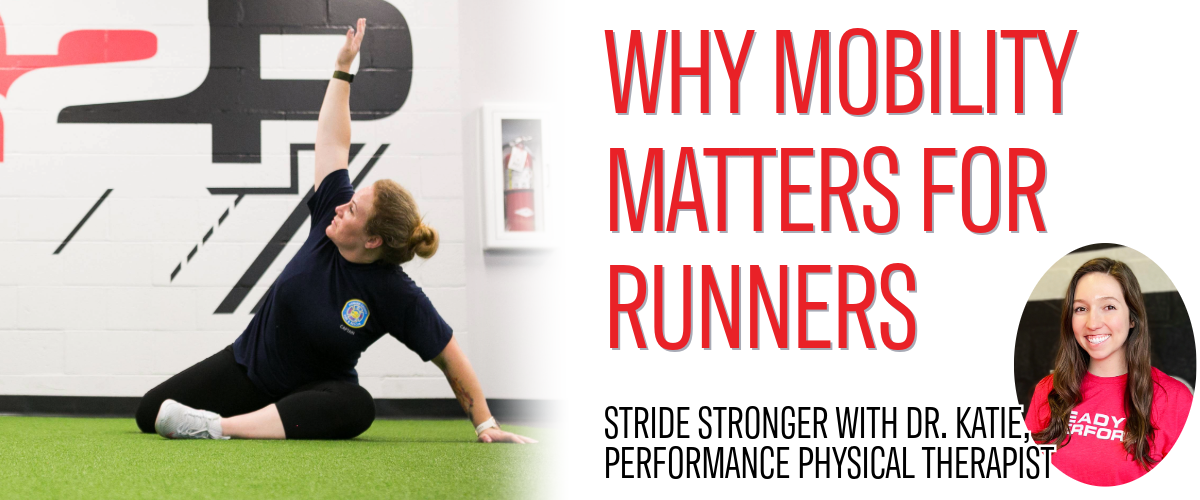How Mobility Impacts Running Performance and Injury Risk

The Role of Mobility in Injury Prevention for Runners
By a Physical Therapist and Runner Who Knows What It Feels Like to Be Sidelined
When most runners think about improving performance or preventing injury, they tend to focus on mileage, strength training, or recovery techniques like foam rolling. But there’s one key piece that often gets overlooked—mobility.
As a physical therapist and someone who runs regularly, I can tell you that mobility work isn’t just a “nice to have” add-on—it’s a foundational part of healthy, sustainable running. If you’re not addressing your joint mobility, you may be limiting your stride, overloading surrounding tissues, and unknowingly increasing your injury risk.
Let’s dig into how mobility impacts your running, how to identify mobility limitations, and simple ways to integrate mobility into your routine.
Why Mobility Matters for Runners
Mobility refers to your body’s ability to actively move a joint through its full range of motion. It’s not just about flexibility—it’s about control, strength, and access to movement.
For runners, mobility is essential for:
- Achieving optimal stride length and efficiency
- Absorbing and transferring force without compensating
- Reducing stress on joints and soft tissues
- Preventing overuse injuries by allowing muscles to work through their full capacity
- Improving posture and breathing mechanics, especially during longer runs
If your ankle, hip, or thoracic spine can’t move well, your body will find a workaround—and that often leads to pain or breakdown in areas like the knees, low back, or foot.
Common Mobility Restrictions That Affect Runners
Ankle Mobility
- Limited dorsiflexion restricts your ability to land and push off efficiently
- Can contribute to shin splints, Achilles pain, and plantar fasciitis
Hip Mobility
- Tight hip flexors, restricted internal rotation, or poor glute activation can disrupt stride mechanics
- Often linked to low back pain, IT band issues, and knee pain
Thoracic Spine (Mid-Back)
- Poor rotation or extension in the mid-back limits arm swing and trunk control
- May lead to compensatory movement at the lower back
Big Toe Mobility
- Lack of extension limits push-off and stride efficiency
- Often overlooked but critical in running mechanics
Signs You May Have a Mobility Problem
Not sure if mobility is limiting you? Here are some red flags to watch for:
- Your stride feels “short” or choppy, even when your legs aren’t tired
- Pain or tightness that doesn’t go away with stretching or foam rolling
- Discomfort during squats, lunges, or drills that test joint range
- Your warm-up takes longer than your run just to feel normal
Mobility limitations don’t always feel like pain—they often show up subtly in your movement quality and performance.
Physical Therapist-Approved Mobility Strategies for Runners
Daily Mobility Drills
- Perform ankle rocks, hip openers, and thoracic rotations for 5–10 minutes
- Incorporate movements like the world’s greatest stretch or lunge with rotation
- Focus on active range of motion—not just passive stretching
Warm-Up With Purpose
- Use dynamic movements before a run to wake up your joints and nervous system
- Include drills like high knees, leg swings, butt kicks, and A-skips
- Prime your joints, not just your heart rate
Mobilize Post-Run, Not Just Before
- Target tight areas with foam rolling and banded mobility work
- Stretch when tissues are warm for improved length and recovery
- Focus on the hip flexors, hamstrings, calves, and T-spine
Use Strength to Reinforce Mobility Gains
- Mobility without strength is unstable—train control in end ranges
- Add exercises like Cossack squats, single-leg deadlifts, and deficit calf raises to your strength routine
- Controlled eccentrics and tempo work help build resilience
The Physical Therapy Perspective
In physical therapy, we look beyond pain points to find root causes. Limited mobility is one of the most common contributing factors to running injuries we see in the clinic. From shin splints to hip pain to recurring Achilles issues, poor joint mobility is often part of the story.
A physical therapist can evaluate your movement patterns, identify where you’re restricted, and guide you through a personalized plan to restore motion and prevent injury.
See How You Move with a Running Performance Analysis
Not sure how your mobility is affecting your stride? At Rehab 2 Perform, we offer a Running Performance Analysis that combines movement screening, mobility assessment, and slow-motion video to help you understand exactly how your body moves when you run.
Whether you’re coming off an injury or want to get ahead of one, this is a powerful tool to keep you running better, longer, and stronger.
Happy running!
-Dr. Katie Woelfel, DPT, OCS | Performance Physical Therapist

Fitness Focused Physical Therapy
Rehab 2 Perform is a leading physical therapy and sports rehabilitation company dedicated to helping clients achieve optimal performance in their daily lives, whether they are athletes, weekend warriors, or individuals recovering from injury. With a team of highly skilled professionals across 12 state-of-the-art locations, Rehab 2 Perform offers a personalized, evidence-based approach that emphasizes active rehabilitation and functional fitness. Find a Location near you, or Schedule Here.
We accept all major insurances, including Tricare, VA Community Care, and the Johns Hopkins Healthcare Network!
